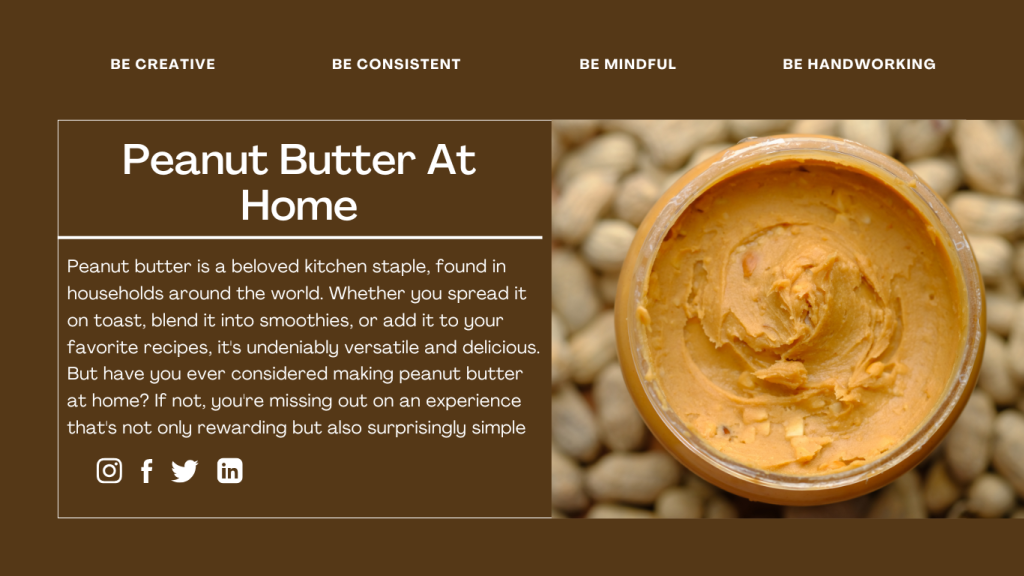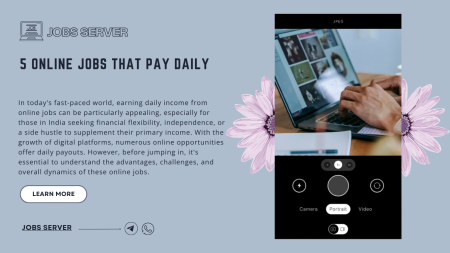How to Make Peanut Butter at Home
INTRODUCTION
Peanut butter is a beloved kitchen staple, found in households around the world. Whether you spread it on toast, blend it into smoothies, or add it to your favorite recipes, it’s undeniably versatile and delicious. But have you ever considered making peanut butter at home? If not, you’re missing out on an experience that’s not only rewarding but also surprisingly simple.
In this article content, I will teach you the importance of making peanut butter at home, walk you through a step-by-step process, and weigh the pros and cons of homemade peanut butter. Plus, I’ll share some personal tips and examples from my peanut butter-making adventures.
- ALSO CHECK
- How To Create A Perfect Home Studio For Content Creation
- Online Businesses That Pay Daily
- Cheapest Businesses To Start From Home
- How To Start A Small Clothing Business From Home
WHY MAKE PEANUT BUTTER AT HOME?
There’s something deeply satisfying about creating your food, especially when it’s as simple yet versatile as peanut butter. Making peanut butter at home isn’t just about recreating a favorite snack. it’s about gaining control over what goes into your food and tweaking the flavor and texture to your exact preferences. And these include:::
1. You Have Control Over Ingredients.
One of the best reasons to make peanut butter at home is the complete control you have over the ingredients. When you buy commercial peanut butter, many brands add sugar, preservatives, hydrogenated oils, and other additives that you might not want in your food. By making peanut butter at home, you can ensure it’s made with 100% natural ingredients—just peanuts and perhaps a pinch of salt or a drizzle of honey if that’s your thing.
2. It Maintains It Freshness And Flavor
Homemade peanut butter is fresher and more flavorful than anything you’ll find in a jar. When peanuts are freshly roasted and ground, their natural oils and flavors are at their peak. The result is a richer, nuttier taste that you simply can’t get from store-bought peanut butter. I remember the first time I made peanut butter at home. The aroma of freshly roasted peanuts filled my kitchen, and when I tasted it, I realized I would never look at store-bought peanut butter the same way again.
3. Its Low Cost
While premium, organic peanut butter brands can get expensive, making peanut butter at home is incredibly affordable. A bag of raw peanuts is often cheaper than a jar of peanut butter, and a little goes a long way. The cost savings become especially noticeable if you’re a peanut butter lover who goes through a jar or two every month (or week—I don’t judge!).
4. It Reduce Waste
By making your peanut butter, you can cut down on packaging waste. Store-bought peanut butter comes in plastic jars, and even though many are recyclable, they still contribute to environmental waste. Buying peanuts in bulk and storing your peanut butter in a reusable glass jar is an eco-friendly option.

STEP-BY-STEP ON HOW TO MAKE PEANUT BUTTER AT HOME
Now that you know why it’s worth making peanut butter at home, let’s get into the process. Making peanut butter is simpler than most people think, and all you need are a few ingredients and a good blender or food processor.
INGREDIENTS:
- 5 cups raw peanuts (you can also use roasted peanuts, but make sure they’re unsalted)
- A pinch of salt (optional)
- 2-3 teaspoons of honey or maple syrup (optional, if you prefer it slightly sweet)
- 1 and 1/2 tablespoons of peanut oil (optional, for extra creaminess)
Step 1: Roast The Peanuts
If you’re using raw peanuts, the first step is to roast them. Spread the peanuts evenly on a baking sheet and place them in a preheated oven at 350°F (175°C) for about 10-15 minutes. Keep a close eye on them, as peanuts can burn quickly. You’ll know they’re ready when they turn a golden brown and release a wonderful, nutty aroma.
For me, I like to roast peanuts with a little sea salt sprinkled on top. It adds a subtle savory flavor to the finished peanut butter without the need for added salt later.
Step 2: Allow The Peanuts Cool
Once roasted, allow the peanuts to cool for a few minutes. This helps the grinding process and ensures that your peanut butter doesn’t end up too hot.
Step 3: Blend the Peanuts
Transfer the cooled peanuts to a food processor or high-speed blender. Blend them on medium speed until they start to break down. At first, the peanuts will form a crumbly mixture, but keep going! As the peanuts release their natural oils, the texture will gradually change and become smoother.
I can remember the first time I made peanut butter, I was impatient and stopped blending too soon. The result was a grainy paste rather than the creamy texture I was aiming for. Lesson learned: patience is key!
Step 4: Add Salt, Sweeteners, or Oil (If You Like)
I love adding a small amount of coconut oil to my peanut butter. It adds a subtle, exotic twist to the flavor, and the texture becomes luxuriously smooth.
At this point, you can add a pinch of salt, honey, or a bit of oil if you’d like. The beauty of homemade peanut butter is that you can customize it to your taste. Want it sweeter? Add more honey. Prefer it ultra-creamy? A drizzle of peanut oil will do the trick.
Step 5: Continue Blending
Blend for another 1-2 minutes until the peanut butter reaches your desired consistency. If you like it chunkier, stop blending sooner. If you prefer it smooth, keep going until it’s perfectly creamy.
Step 6: Store Your Peanut Butter
Transfer the freshly made peanut butter into an airtight container, preferably a glass jar. It can be stored at room temperature for about a week or in the refrigerator for longer (up to a month). Just remember to give it a good stir before each use, as natural peanut butter tends to separate over time.
Step 7: Your Peanut Butter At Home Is Ready!
You’ve done it! You’ve made delicious, homemade peanut butter. Now, you can enjoy it in all your favorite ways. spread on toast, mixed into oatmeal, or simply eaten with a spoonful.
A VIDEO ON HOW TO MAKE PEANUT BUTTER AT HOME
ADVANTAGES OF MAKING PEANUT BUTTER AT HOME
1. You Will Be Able To Customization
One of the biggest advantages of making peanut butter at home is the ability to tailor it to your preferences. You have complete control whether you like it salty, sweet, crunchy, or smooth. Plus, you can experiment with different flavors by adding cocoa powder for chocolate peanut butter or cinnamon for a warm, spiced version.
Personal Example: One of my favorite customizations is adding a spoonful of dark chocolate chips to the food processor during the final stages of blending. It creates a slightly crunchy, chocolate-infused peanut butter that’s perfect on toast or pancakes.
2. No Additives
Homemade peanut butter is as natural as it gets. There are no hidden ingredients, preservatives, or artificial flavors. just pure, wholesome peanuts. It’s a great option for those looking to avoid processed foods.
3. It’s Affordable
As mentioned earlier, making peanut butter at home can save you money, especially if you buy peanuts in bulk. It’s a cost-effective way to enjoy high-quality peanut butter without breaking the bank.
4. It’s Eco-Friendly
By using reusable containers and buying peanuts in bulk, you reduce the amount of plastic waste that comes with store-bought peanut butter. It’s a small but meaningful step toward more sustainable living.
DISADVANTAGES OF MAKING PEANUT BUTTER AT HOME
1. It Wastes Time And Effort
While making peanut butter at home isn’t difficult, it does require some time and effort. Between roasting the peanuts, letting them cool, and blending them, it’s not as quick as grabbing a jar from the shelf. However, once you get the hang of it, the whole process takes less than 20 minutes.
2. Shelf Life
Homemade peanut butter doesn’t last as long as store-bought versions because it lacks preservatives. It’s best consumed within a few weeks if stored in the refrigerator, whereas commercial peanut butter can last for months.
3. Oil Separation
Natural peanut butter tends to separate, with the oil rising to the top. While this is completely normal, it can be inconvenient, as you’ll need to stir it before each use. Some people find this annoying compared to the smooth consistency of store-bought peanut butter with added stabilizers.
MY FINAL THOUGHTS
Making peanut butter at home is a rewarding experience that allows you to enjoy a fresher, healthier, and more customizable version of this beloved spread. While it does take a bit more time and effort than buying a jar at the store, the benefits far outweigh the downsides. You get to control the ingredients, experiment with flavors, and enjoy the satisfaction of creating something delicious from scratch.
Whether you’re a peanut butter fanatic or just curious about trying something new, making peanut butter at home is an experience worth savoring! So grab some peanuts, fire up your food processor, and give it a try. You might just find that homemade peanut butter becomes your new favorite kitchen creation.
SOME ASKED QUESTIONS ON HOW TO MAKE PEANUT BUTTER AT HOME
- Is it cheaper to make peanut butter at home?
Yes, making peanut butter at home How to Make Peanut Butter at Homeis often cheaper than buying store-bought versions, especially if you buy peanuts in bulk. You’ll save money while enjoying fresh, additive-free peanut butter.
- How long does homemade peanut butter last?
Homemade peanut butter can last up to a month when stored in an airtight container in the refrigerator. Since it lacks preservatives, it should be consumed within a few weeks for the best taste.
- Do I need to add oil to make peanut butter at home?
No, you don’t need to add oil! Peanuts naturally release oils as they’re blended. However, if you prefer creamier peanut butter, a small amount of peanut or coconut oil can help achieve a smoother texture.
- Can I use salted peanuts to make peanut butter?
Yes, you can use salted peanuts, but the resulting peanut butter may be quite salty. If you prefer a milder taste, opt for unsalted peanuts and add salt gradually to your preference.
- How do you keep homemade peanut butter from separating?
Oil separation is common in natural peanut butter. To prevent it, store your peanut butter in the fridge and stir it before each use. If separation bothers you, you can blend it again to recombine the oils.
- Can I make peanut butter without a food processor?
Yes, you can use a high-speed blender instead of a food processor. Just be sure to scrape down the sides frequently to ensure even blending. It may take a bit longer, but it’s still doable!
- What types of peanuts are best for making peanut butter?
Raw or dry-roasted peanuts are ideal. You can roast raw peanuts yourself for maximum freshness. Avoid peanuts with added flavors or oils for the purest, most natural peanut butter.
- Can I add flavors to homemade peanut butter?
Absolutely! You can mix in honey, cinnamon, or even chocolate chips for a fun twist. The beauty of homemade peanut butter is that you can customize it however you like.
- Is homemade peanut butter healthier than store-bought?
Yes, homemade peanut butter is typically healthier because it contains no preservatives, added sugars, or hydrogenated oils. You control the ingredients, making it as healthy as you want.
- Can I make crunchy peanut butter at home?
Yes! To make crunchy peanut butter, blend most of the peanuts into a smooth consistency, then stir in some chopped or roughly blended peanuts at the end for added crunch.





